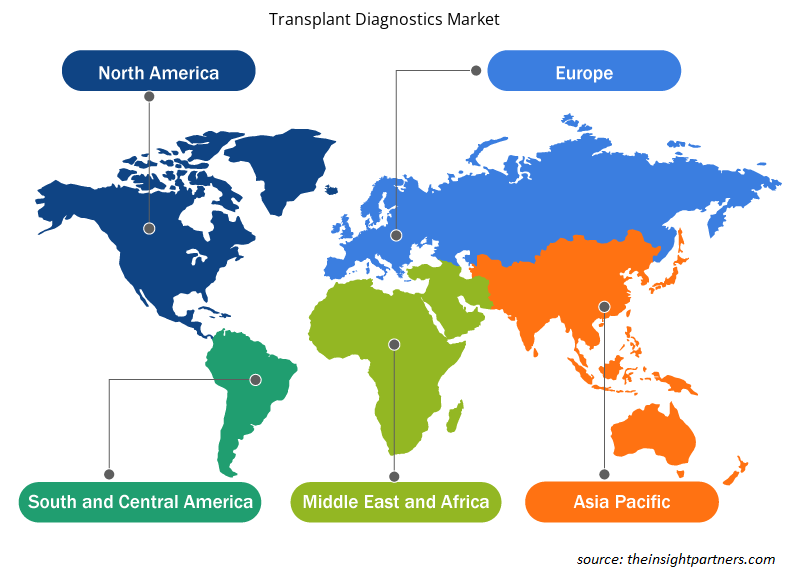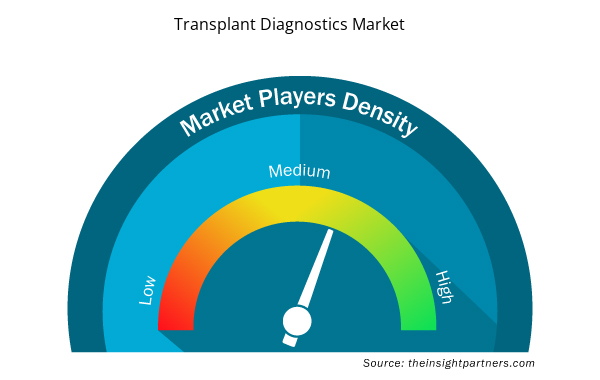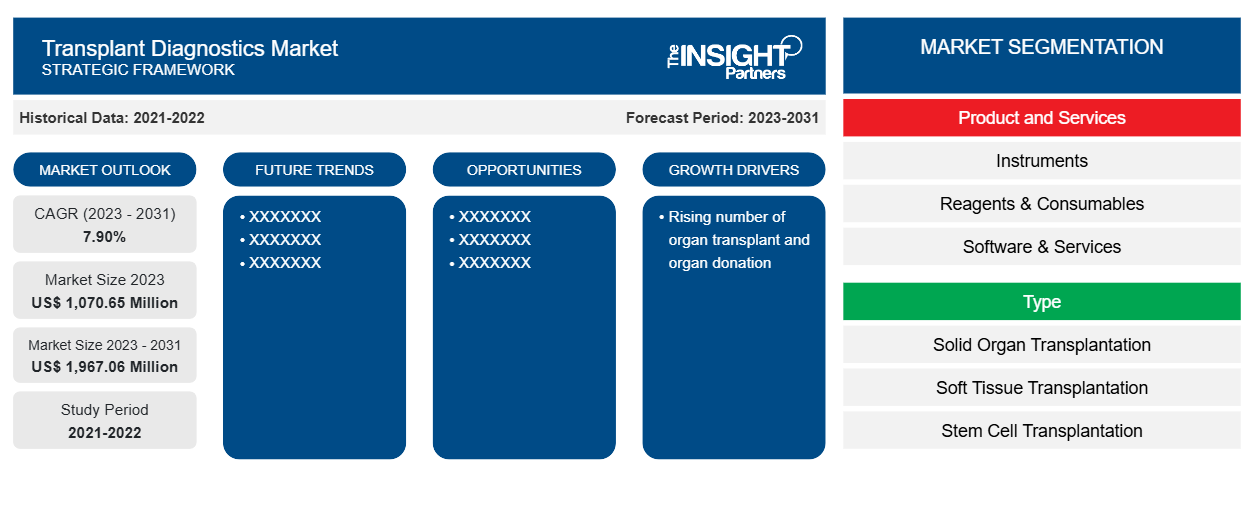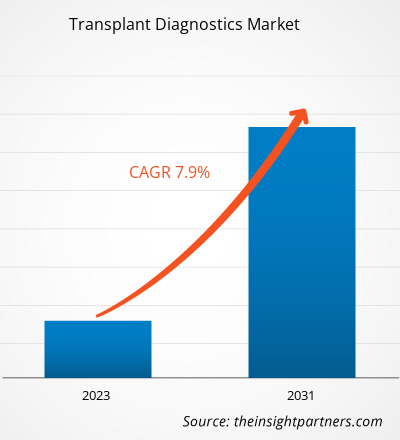Der Markt für Transplantationsdiagnostik soll von 1.070,65 Millionen US-Dollar im Jahr 2023 auf 1.967,06 Millionen US-Dollar im Jahr 2031 anwachsen. Der Markt soll in den Jahren 2023–2031 eine durchschnittliche jährliche Wachstumsrate (CAGR) von 7,90 % verzeichnen. Die weltweit steigende Zahl von Organtransplantationen, wie Leber-, Nieren-, Herz- und Lungentransplantationen, dürfte die Nachfrage nach Transplantationsdiagnostik ankurbeln und damit das allgemeine Marktwachstum ankurbeln. Darüber hinaus dürfte die zunehmende Verbreitung von Organversagen und chronischen Krankheiten, die Transplantationen erfordern, weiterhin wichtige Trends auf dem Markt für Transplantationsdiagnostik bleiben.
Marktanalyse für Transplantationsdiagnostik
Die Transplantation ist eine der bevorzugten Behandlungen für Patienten, die an Nierenerkrankungen leiden und sich einer chronischen Dialysetherapie unterziehen. Sie ist auch eine sinnvolle Option für Patienten, die an Herz- oder Lebererkrankungen leiden. Die Diagnostik hat sich weltweit deutlich verbessert, da Unternehmen bessere HLA-Typisierungstechnologien, Antikörperüberwachung, Instrumente und Software entwickelt haben. Diese Technologie wird zur Diagnostik bei Organtransplantationen eingesetzt. Fortschritte bei Transplantationsverfahren bieten erhebliche Chancen für Marktwachstum.
Marktübersicht für Transplantationsdiagnostik
Nordamerika ist der größte Markt für das Wachstum im Bereich Transplantationsdiagnostik, wobei die USA den größten Marktanteil halten, gefolgt von Kanada. Das Wachstum in Nordamerika ist durch die steigende Zahl von Organtransplantationen und die steigende Prävalenz von Organversagen in dieser Region gekennzeichnet. Laut den im United Network for Organ Sharing.org veröffentlichten Daten werden im Jahr 2023 in den USA schätzungsweise 46.630 Transplantationen durchgeführt. Laut donatelife.net erreichten die USA im Jahr 2022 einen historischen Meilenstein und führten im Vergleich zu jedem anderen Land der Welt rund 1 Million Organtransplantationen durch. Im Jahr 2023 schenkten mehr als 23.000 Spender den Empfängern und ihren Familien neues Leben. Darüber hinaus stehen etwa 100.000 Menschen auf der Warteliste für lebensrettende Organtransplantationen. Daher wird die steigende Zahl der Organtransplantationen im Land in den kommenden Jahren wahrscheinlich das Marktwachstum vorantreiben.
Passen Sie diesen Bericht Ihren Anforderungen an
Sie erhalten kostenlos individuelle Anpassungen an jedem Bericht, einschließlich Teilen dieses Berichts oder einer Analyse auf Länderebene, eines Excel-Datenpakets sowie tolle Angebote und Rabatte für Start-ups und Universitäten.
- Holen Sie sich die wichtigsten Markttrends aus diesem Bericht.Dieses KOSTENLOSE Beispiel umfasst eine Datenanalyse von Markttrends bis hin zu Schätzungen und Prognosen.
Treiber und Chancen auf dem Transplantationsdiagnostikmarkt
Steigende Zahl chronischer Krankheiten, die Organtransplantationen erfordern, begünstigt den Markt
Der steigende Bedarf an Organtransplantationen wird durch die zunehmende Verbreitung chronischer Krankheiten wie Diabetes und Nierenerkrankungen ergänzt, was den Markt für Transplantationsdiagnostik weiter antreibt. Laut den von der University of California San Francisco veröffentlichten Daten erkranken beispielsweise jedes Jahr rund 750.000 Patienten in den Vereinigten Staaten und schätzungsweise 2 Millionen Patienten weltweit an Nierenversagen. Aufgrund dieser Organversagen steigt daher auch der Bedarf an Spendernieren in den USA um 8 % pro Jahr. Länder wie Japan, Taiwan, Mexiko, die USA und Belgien weisen die höchste Prävalenz von Nierenversagen auf.
Integration von KI und maschinellem Lernen – eine Chance auf dem Markt für Transplantationsdiagnostik
Eine Kombination aus künstlicher Intelligenz (KI) und maschinellen Lernalgorithmen hat auf dem Markt für Transplantationsdiagnostik vielversprechende Ergebnisse gezeigt und kann die Behandlungsergebnisse verbessern, die Datenanalyse beschleunigen und die Diagnosegenauigkeit erhöhen, was zu einer Marktexpansion führen kann. Die Nachfrage nach Transplantationen ist aufgrund verschiedener Schlüsselfaktoren gestiegen, wie z. B. einer alternden Bevölkerung, der steigenden Verbreitung chronischer Krankheiten und Fortschritten bei medizinischen Geräten, die es einem größeren Patientenkreis ermöglichen, für eine Transplantation in Frage zu kommen.
Segmentierungsanalyse des Marktberichts zur Transplantationsdiagnostik
Wichtige Segmente, die zur Ableitung der Marktanalyse für Transplantationsdiagnostik beigetragen haben, sind Produkt und Dienstleistungen, Typ, Technologie und Endbenutzer.
- Basierend auf Produkten und Dienstleistungen ist der Markt für Transplantationsdiagnostik in Instrumente, Reagenzien und Verbrauchsmaterialien sowie Software und Dienstleistungen unterteilt. Instrumente, Reagenzien und Verbrauchsmaterialien sowie Software und Dienstleistungen. Die Reagenzien und Verbrauchsmaterialien hatten 2023 den größten Marktanteil. Software und Dienstleistungen verzeichneten im Prognosezeitraum 2023–2031 die höchste durchschnittliche jährliche Wachstumsrate.CAGR over the forecast period 2023-2031.
- Nach Typ ist der Markt in Transplantationen fester Organe , Weichteiltransplantationen und Stammzelltransplantationen unterteilt. Das Segment der Transplantationen fester Organe hatte im Jahr 2023 den größten Marktanteil.
- Nach Technologie ist der Markt in molekulare und nichtmolekulare Tests unterteilt. Das Segment der molekularen Tests dürfte im Prognosezeitraum die höchste durchschnittliche jährliche Wachstumsrate verzeichnen.
- Nach Endnutzer ist der Markt in Krankenhäuser und Transplantationszentren, Forschungslabore und akademische Institute sowie unabhängige Referenzlabore unterteilt. Das Segment Krankenhäuser und Transplantationszentren hatte im Jahr 2023 den größten Marktanteil.
Transplantationsdiagnostik Marktanteilsanalyse nach Geografie
Der geografische Umfang des Berichts zum Markt für Transplantationsdiagnostik ist hauptsächlich in fünf Regionen unterteilt: Nordamerika, Asien-Pazifik, Europa, Naher Osten und Afrika sowie Süd- und Mittelamerika.
Nordamerika dominiert den Markt für Transplantationsdiagnostik. Das Marktwachstum ist auf eine zunehmende Prävalenz von Organversagen zurückzuführen, und eine steigende Zahl von Organspenden sowie Organtransplantationen treibt das regionale Marktwachstum an. So heißt es beispielsweise laut den von der Association of Organ Procurement Organizations (AOPO), einer gemeinnützigen Organisation in den USA, veröffentlichten Daten, dass im Januar 2021 mehr als 12.500 Menschen im Jahr 2020 ein oder mehrere Organe gespendet haben und die Zahl der von verstorbenen Spendern gespendeten Organe auf über 36.500 gestiegen ist, was einer Steigerung von fast 2 % gegenüber dem Vorjahr entspricht. Darüber hinaus haben Organe von Toten in den letzten sieben Jahren mehr als 33.000 Leben gerettet.
Daher führt der Anstieg der Organspenden zu einem erhöhten Bedarf an diagnostischen Tests für Transplantationen und treibt so das Wachstum des Marktes voran.
Regionale Einblicke in den Markt für Transplantationsdiagnostik
Die regionalen Trends und Faktoren, die den Markt für Transplantationsdiagnostik im Prognosezeitraum beeinflussen, wurden von den Analysten von Insight Partners ausführlich erläutert. In diesem Abschnitt werden auch die Marktsegmente und die Geografie der Transplantationsdiagnostik in Nordamerika, Europa, im asiatisch-pazifischen Raum, im Nahen Osten und Afrika sowie in Süd- und Mittelamerika erörtert.

- Erhalten Sie regionale Daten zum Markt für Transplantationsdiagnostik
Umfang des Marktberichts zur Transplantationsdiagnostik
| Berichtsattribut | Details |
|---|---|
| Marktgröße im Jahr 2023 | 1.070,65 Millionen US-Dollar |
| Marktgröße bis 2031 | 1.967,06 Millionen US-Dollar |
| Globale CAGR (2023 - 2031) | 7,90 % |
| Historische Daten | 2021-2022 |
| Prognosezeitraum | 2023–2031 |
| Abgedeckte Segmente | Nach Produkten und Dienstleistungen
|
| Abgedeckte Regionen und Länder | Nordamerika
|
| Marktführer und wichtige Unternehmensprofile |
|
Marktteilnehmerdichte: Der Einfluss auf die Geschäftsdynamik
Der Markt für Transplantationsdiagnostik wächst rasant, angetrieben durch die steigende Nachfrage der Endnutzer aufgrund von Faktoren wie sich entwickelnden Verbraucherpräferenzen, technologischen Fortschritten und einem größeren Bewusstsein für die Vorteile des Produkts. Mit steigender Nachfrage erweitern Unternehmen ihr Angebot, entwickeln Innovationen, um die Bedürfnisse der Verbraucher zu erfüllen, und nutzen neue Trends, was das Marktwachstum weiter ankurbelt.
Die Marktteilnehmerdichte bezieht sich auf die Verteilung der Firmen oder Unternehmen, die in einem bestimmten Markt oder einer bestimmten Branche tätig sind. Sie gibt an, wie viele Wettbewerber (Marktteilnehmer) in einem bestimmten Marktraum im Verhältnis zu seiner Größe oder seinem gesamten Marktwert präsent sind.
Die wichtigsten auf dem Markt für Transplantationsdiagnostik tätigen Unternehmen sind:
- Bio-Rad Laboratories,
- Hologic,
- Illumina, Inc.,
- Thermo Fisher Scientific,
- QIAGEN NV
- Omixon, Inc.
Haftungsausschluss : Die oben aufgeführten Unternehmen sind nicht in einer bestimmten Reihenfolge aufgeführt.

- Überblick über die wichtigsten Akteure auf dem Markt für Transplantationsdiagnostik
Neuigkeiten und aktuelle Entwicklungen zum Markt für Transplantationsdiagnostik
Der Markt für Transplantationsdiagnostik wird durch die Erhebung qualitativer und quantitativer Daten nach Primär- und Sekundärforschung bewertet, die wichtige Unternehmensveröffentlichungen, Verbandsdaten und Datenbanken umfasst. Im Folgenden finden Sie eine Liste der Entwicklungen auf dem Markt für Transplantationsdiagnostik:
- Thermo Fisher Scientific hat während der Jahreskonferenz der American Society for Histocompatibility and Immunogenetics (ASHI) sein Portfolio für Transplantationsdiagnostik um zwei neue Produkte erweitert. (Quelle: Thermo Fisher Scientific, Pressemitteilung/Unternehmenswebsite/Newsletter, Oktober 2023)
- Immucor, Inc., ein auf Transfusions- und Transplantationsdiagnostik spezialisiertes Unternehmen, gab zwei Erweiterungen seines Transplantationsdiagnostik-Portfolios bekannt und unterstreicht damit sein anhaltendes Engagement für neue Fortschritte auf dem Gebiet der Histokompatibilität. (Quelle: Immucor, Pressemitteilung/Unternehmenswebsite/Newsletter, März 2022)
- Biocartis und Ophiomics sind eine Zusammenarbeit eingegangen, um sich auf die Kommerzialisierung von HepatoPredict zu konzentrieren, einem prognostischen Genexpressionssignaturtest zur Ermittlung, welche Patienten von einer Lebertransplantation profitieren werden (Quelle: Biocartis, Pressemitteilung/Unternehmenswebsite/Newsletter, März 2022)
Marktbericht zur Transplantationsdiagnostik – Umfang und Ergebnisse
Der Bericht „Marktgröße und Prognose für Transplantationsdiagnostik (2021–2031)“ bietet eine detaillierte Analyse des Marktes, die die folgenden Bereiche abdeckt:
- Marktgröße und Prognose auf globaler, regionaler und Länderebene für alle wichtigen Marktsegmente, die im Rahmen des Projekts abgedeckt sind
- Marktdynamik wie Treiber, Beschränkungen und wichtige Chancen
- Wichtige Zukunftstrends
- Detaillierte PEST/Porters Five Forces- und SWOT-Analyse
- Globale und regionale Marktanalyse mit wichtigen Markttrends, wichtigen Akteuren, Vorschriften und aktuellen Marktentwicklungen
- Branchenlandschaft und Wettbewerbsanalyse, einschließlich Marktkonzentration, Heatmap-Analyse, prominenten Akteuren und aktuellen Entwicklungen
- Detaillierte Firmenprofile
- Historische Analyse (2 Jahre), Basisjahr, Prognose (7 Jahre) mit CAGR
- PEST- und SWOT-Analyse
- Marktgröße Wert/Volumen – Global, Regional, Land
- Branche und Wettbewerbsumfeld
- Excel-Datensatz



Report Coverage
Revenue forecast, Company Analysis, Industry landscape, Growth factors, and Trends

Segment Covered
This text is related
to segments covered.

Regional Scope
North America, Europe, Asia Pacific, Middle East & Africa, South & Central America

Country Scope
This text is related
to country scope.
Trends and growth analysis reports related to Life Sciences : READ MORE..
The Insight Partners performs research in 4 major stages: Data Collection & Secondary Research, Primary Research, Data Analysis and Data Triangulation & Final Review.
- Data Collection and Secondary Research:
As a market research and consulting firm operating from a decade, we have published and advised several client across the globe. First step for any study will start with an assessment of currently available data and insights from existing reports. Further, historical and current market information is collected from Investor Presentations, Annual Reports, SEC Filings, etc., and other information related to company’s performance and market positioning are gathered from Paid Databases (Factiva, Hoovers, and Reuters) and various other publications available in public domain.
Several associations trade associates, technical forums, institutes, societies and organization are accessed to gain technical as well as market related insights through their publications such as research papers, blogs and press releases related to the studies are referred to get cues about the market. Further, white papers, journals, magazines, and other news articles published in last 3 years are scrutinized and analyzed to understand the current market trends.
- Primary Research:
The primarily interview analysis comprise of data obtained from industry participants interview and answers to survey questions gathered by in-house primary team.
For primary research, interviews are conducted with industry experts/CEOs/Marketing Managers/VPs/Subject Matter Experts from both demand and supply side to get a 360-degree view of the market. The primary team conducts several interviews based on the complexity of the markets to understand the various market trends and dynamics which makes research more credible and precise.
A typical research interview fulfils the following functions:
- Provides first-hand information on the market size, market trends, growth trends, competitive landscape, and outlook
- Validates and strengthens in-house secondary research findings
- Develops the analysis team’s expertise and market understanding
Primary research involves email interactions and telephone interviews for each market, category, segment, and sub-segment across geographies. The participants who typically take part in such a process include, but are not limited to:
- Industry participants: VPs, business development managers, market intelligence managers and national sales managers
- Outside experts: Valuation experts, research analysts and key opinion leaders specializing in the electronics and semiconductor industry.
Below is the breakup of our primary respondents by company, designation, and region:

Once we receive the confirmation from primary research sources or primary respondents, we finalize the base year market estimation and forecast the data as per the macroeconomic and microeconomic factors assessed during data collection.
- Data Analysis:
Once data is validated through both secondary as well as primary respondents, we finalize the market estimations by hypothesis formulation and factor analysis at regional and country level.
- Macro-Economic Factor Analysis:
We analyse macroeconomic indicators such the gross domestic product (GDP), increase in the demand for goods and services across industries, technological advancement, regional economic growth, governmental policies, the influence of COVID-19, PEST analysis, and other aspects. This analysis aids in setting benchmarks for various nations/regions and approximating market splits. Additionally, the general trend of the aforementioned components aid in determining the market's development possibilities.
- Country Level Data:
Various factors that are especially aligned to the country are taken into account to determine the market size for a certain area and country, including the presence of vendors, such as headquarters and offices, the country's GDP, demand patterns, and industry growth. To comprehend the market dynamics for the nation, a number of growth variables, inhibitors, application areas, and current market trends are researched. The aforementioned elements aid in determining the country's overall market's growth potential.
- Company Profile:
The “Table of Contents” is formulated by listing and analyzing more than 25 - 30 companies operating in the market ecosystem across geographies. However, we profile only 10 companies as a standard practice in our syndicate reports. These 10 companies comprise leading, emerging, and regional players. Nonetheless, our analysis is not restricted to the 10 listed companies, we also analyze other companies present in the market to develop a holistic view and understand the prevailing trends. The “Company Profiles” section in the report covers key facts, business description, products & services, financial information, SWOT analysis, and key developments. The financial information presented is extracted from the annual reports and official documents of the publicly listed companies. Upon collecting the information for the sections of respective companies, we verify them via various primary sources and then compile the data in respective company profiles. The company level information helps us in deriving the base number as well as in forecasting the market size.
- Developing Base Number:
Aggregation of sales statistics (2020-2022) and macro-economic factor, and other secondary and primary research insights are utilized to arrive at base number and related market shares for 2022. The data gaps are identified in this step and relevant market data is analyzed, collected from paid primary interviews or databases. On finalizing the base year market size, forecasts are developed on the basis of macro-economic, industry and market growth factors and company level analysis.
- Data Triangulation and Final Review:
The market findings and base year market size calculations are validated from supply as well as demand side. Demand side validations are based on macro-economic factor analysis and benchmarks for respective regions and countries. In case of supply side validations, revenues of major companies are estimated (in case not available) based on industry benchmark, approximate number of employees, product portfolio, and primary interviews revenues are gathered. Further revenue from target product/service segment is assessed to avoid overshooting of market statistics. In case of heavy deviations between supply and demand side values, all thes steps are repeated to achieve synchronization.
We follow an iterative model, wherein we share our research findings with Subject Matter Experts (SME’s) and Key Opinion Leaders (KOLs) until consensus view of the market is not formulated – this model negates any drastic deviation in the opinions of experts. Only validated and universally acceptable research findings are quoted in our reports.
We have important check points that we use to validate our research findings – which we call – data triangulation, where we validate the information, we generate from secondary sources with primary interviews and then we re-validate with our internal data bases and Subject matter experts. This comprehensive model enables us to deliver high quality, reliable data in shortest possible time.


 Holen Sie sich ein kostenloses Muster für diesen Bericht
Holen Sie sich ein kostenloses Muster für diesen Bericht